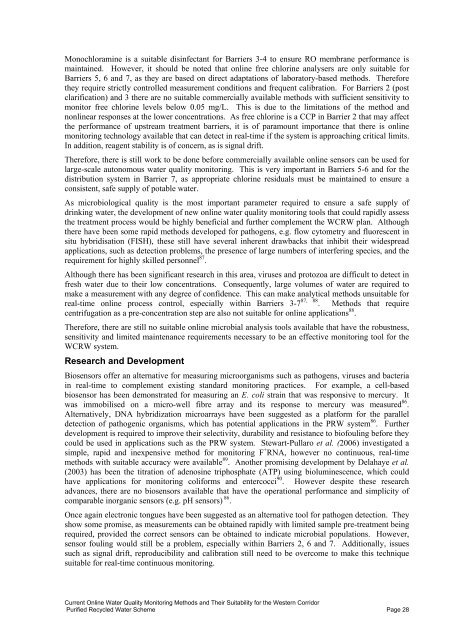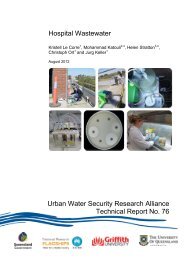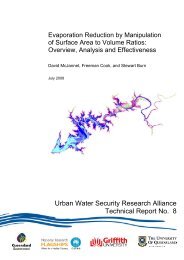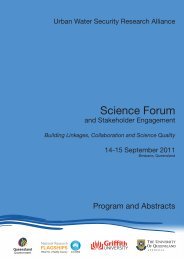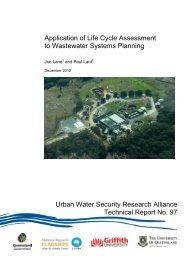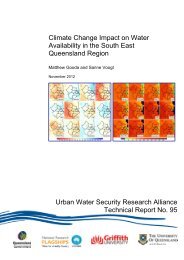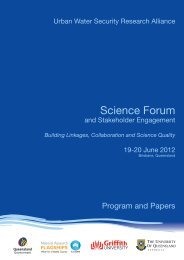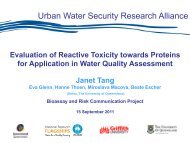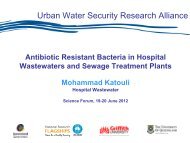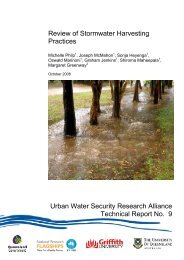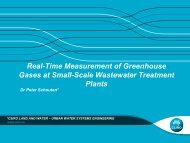Current online water quality monitoring methods and their suitability ...
Current online water quality monitoring methods and their suitability ...
Current online water quality monitoring methods and their suitability ...
Create successful ePaper yourself
Turn your PDF publications into a flip-book with our unique Google optimized e-Paper software.
Monochloramine is a suitable disinfectant for Barriers 3-4 to ensure RO membrane performance ismaintained. However, it should be noted that <strong>online</strong> free chlorine analysers are only suitable forBarriers 5, 6 <strong>and</strong> 7, as they are based on direct adaptations of laboratory-based <strong>methods</strong>. Thereforethey require strictly controlled measurement conditions <strong>and</strong> frequent calibration. For Barriers 2 (postclarification) <strong>and</strong> 3 there are no suitable commercially available <strong>methods</strong> with sufficient sensitivity tomonitor free chlorine levels below 0.05 mg/L. This is due to the limitations of the method <strong>and</strong>n<strong>online</strong>ar responses at the lower concentrations. As free chlorine is a CCP in Barrier 2 that may affectthe performance of upstream treatment barriers, it is of paramount importance that there is <strong>online</strong><strong>monitoring</strong> technology available that can detect in real-time if the system is approaching critical limits.In addition, reagent stability is of concern, as is signal drift.Therefore, there is still work to be done before commercially available <strong>online</strong> sensors can be used forlarge-scale autonomous <strong>water</strong> <strong>quality</strong> <strong>monitoring</strong>. This is very important in Barriers 5-6 <strong>and</strong> for thedistribution system in Barrier 7, as appropriate chlorine residuals must be maintained to ensure aconsistent, safe supply of potable <strong>water</strong>.As microbiological <strong>quality</strong> is the most important parameter required to ensure a safe supply ofdrinking <strong>water</strong>, the development of new <strong>online</strong> <strong>water</strong> <strong>quality</strong> <strong>monitoring</strong> tools that could rapidly assessthe treatment process would be highly beneficial <strong>and</strong> further complement the WCRW plan. Althoughthere have been some rapid <strong>methods</strong> developed for pathogens, e.g. flow cytometry <strong>and</strong> fluorescent insitu hybridisation (FISH), these still have several inherent drawbacks that inhibit <strong>their</strong> widespreadapplications, such as detection problems, the presence of large numbers of interfering species, <strong>and</strong> therequirement for highly skilled personnel 87 .Although there has been significant research in this area, viruses <strong>and</strong> protozoa are difficult to detect infresh <strong>water</strong> due to <strong>their</strong> low concentrations. Consequently, large volumes of <strong>water</strong> are required tomake a measurement with any degree of confidence. This can make analytical <strong>methods</strong> unsuitable forreal-time <strong>online</strong> process control, especially within Barriers 3-7 87, 88 . Methods that requirecentrifugation as a pre-concentration step are also not suitable for <strong>online</strong> applications 88 .Therefore, there are still no suitable <strong>online</strong> microbial analysis tools available that have the robustness,sensitivity <strong>and</strong> limited maintenance requirements necessary to be an effective <strong>monitoring</strong> tool for theWCRW system.Research <strong>and</strong> DevelopmentBiosensors offer an alternative for measuring microorganisms such as pathogens, viruses <strong>and</strong> bacteriain real-time to complement existing st<strong>and</strong>ard <strong>monitoring</strong> practices. For example, a cell-basedbiosensor has been demonstrated for measuring an E. coli strain that was responsive to mercury. Itwas immobilised on a micro-well fibre array <strong>and</strong> its response to mercury was measured 86 .Alternatively, DNA hybridization microarrays have been suggested as a platform for the paralleldetection of pathogenic organisms, which has potential applications in the PRW system 86 . Furtherdevelopment is required to improve <strong>their</strong> selectivity, durability <strong>and</strong> resistance to biofouling before theycould be used in applications such as the PRW system. Stewart-Pullaro et al. (2006) investigated asimple, rapid <strong>and</strong> inexpensive method for <strong>monitoring</strong> F + RNA, however no continuous, real-time<strong>methods</strong> with suitable accuracy were available 89 . Another promising development by Delahaye et al.(2003) has been the titration of adenosine triphosphate (ATP) using bioluminescence, which couldhave applications for <strong>monitoring</strong> coliforms <strong>and</strong> entercocci 90 . However despite these researchadvances, there are no biosensors available that have the operational performance <strong>and</strong> simplicity ofcomparable inorganic sensors (e.g. pH sensors) 86 .Once again electronic tongues have been suggested as an alternative tool for pathogen detection. Theyshow some promise, as measurements can be obtained rapidly with limited sample pre-treatment beingrequired, provided the correct sensors can be obtained to indicate microbial populations. However,sensor fouling would still be a problem, especially within Barriers 2, 6 <strong>and</strong> 7. Additionally, issuessuch as signal drift, reproducibility <strong>and</strong> calibration still need to be overcome to make this techniquesuitable for real-time continuous <strong>monitoring</strong>.<strong>Current</strong> Online Water Quality Monitoring Methods <strong>and</strong> Their Suitability for the Western CorridorPurified Recycled Water Scheme Page 28


